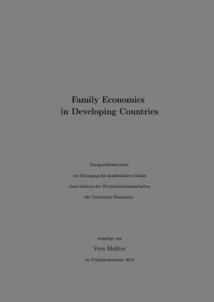|
Family economics in developing countries
Molitor, Vera
![[img]](https://madoc.bib.uni-mannheim.de/style/images/fileicons/application_pdf.png)  Vorschau |
|
PDF
Dissertation_Molitor-147bearbeitet-A2b.pdf
- Veröffentlichte Version
Download (3MB)
|
|
URL:
|
https://madoc.bib.uni-mannheim.de/36680
|
|
URN:
|
urn:nbn:de:bsz:180-madoc-366801
|
|
Dokumenttyp:
|
Dissertation
|
|
Erscheinungsjahr:
|
2014
|
|
Ort der Veröffentlichung:
|
Mannheim
|
|
Hochschule:
|
Universität Mannheim
|
|
Gutachter:
|
Tertilt, Michèle
|
|
Datum der mündl. Prüfung:
|
3 Juni 2014
|
|
Sprache der Veröffentlichung:
|
Englisch
|
|
Einrichtung:
|
Fakultät für Rechtswissenschaft und Volkswirtschaftslehre > Makro- u. Entwicklungsökonomie (Tertilt 2010-)
Außerfakultäre Einrichtungen > GESS - CDSE (VWL)
|
|
Fachgebiet:
|
330 Wirtschaft
|
|
Fachklassifikation:
|
JEL:
O11, O12, O55, J12, J16, J13, J16,
|
|
Normierte Schlagwörter (SWD):
|
Familienökonomie , Entwicklungsökonomie , Beschneidung <Frau> , Fertilität , Geburtenrate
|
|
Freie Schlagwörter (Deutsch):
|
Weibliche Genitalverstümmelung
|
|
Freie Schlagwörter (Englisch):
|
Female genital cutting/mutilation , marriage market , premarital investment , female empowerment , education , fertility
|
|
Abstract:
|
This dissertation covers two topics within the research area of family economics: violence against women in the form of female genital cutting and gender differences in fertility choices. In Part I of my dissertation, I analyze the harmful tradition of female genital cutting (FGC) from an economic perspective. It is estimated that 80 to 130 million women are circumcised/mutilated worldwide, with 3 million girls at risk of undergoing this procedure every year. Chapter 2 starts with a cross-country analysis and connects FGC rates with women's status in different countries. Chapter 3 places its emphasis on within-country variation and the interaction of FGC with marriage and education. In both chapters, the analysis and discussion of policies to reduce FGC play an important role. Part II focuses on fertility outcomes, in particular on differences in completed fertility by gender and the role of polygyny for potential fertility gaps in developing countries.
|
 | Dieser Eintrag ist Teil der Universitätsbibliographie. |
 | Das Dokument wird vom Publikationsserver der Universitätsbibliothek Mannheim bereitgestellt. |
 Suche Autoren in Suche Autoren in
Sie haben einen Fehler gefunden? Teilen Sie uns Ihren Korrekturwunsch bitte hier mit: E-Mail
Actions (login required)
 |
Eintrag anzeigen |
|
|
